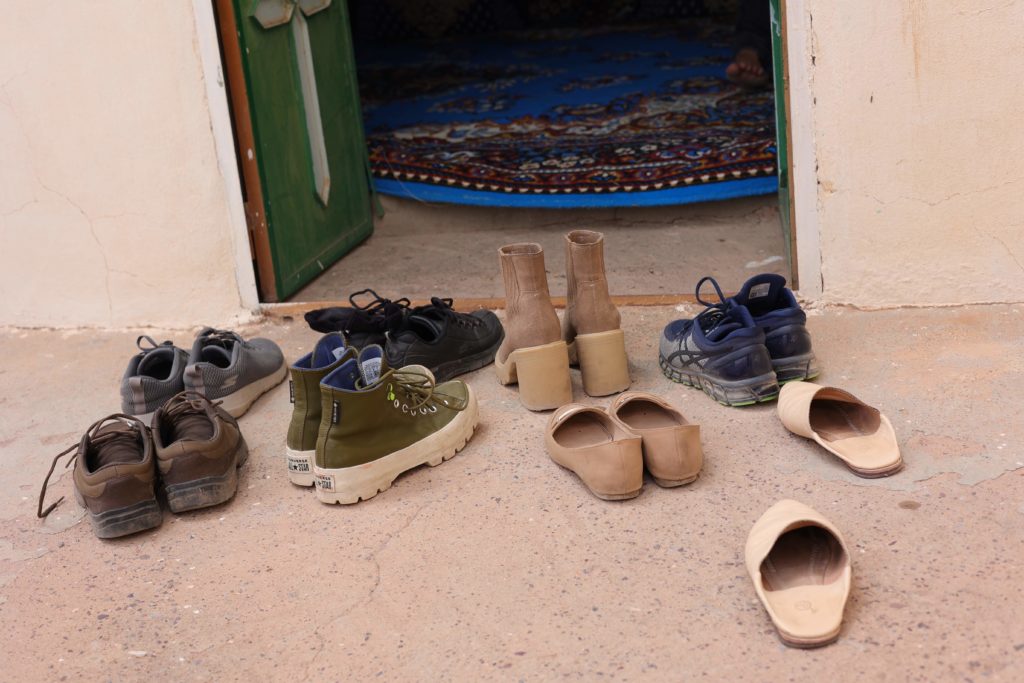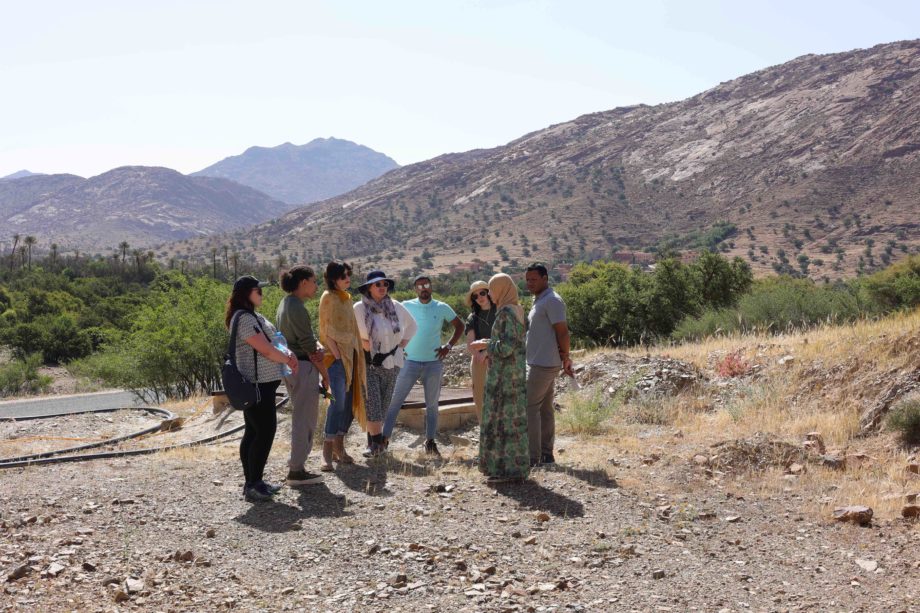WRAP REPORT: STORYTELLING EXPEDITION TO MOROCCO 2023
In a world where travel is often reduced to checking off a list of tourist destinations, we embarked on a different kind of journey. Our Storytelling Expedition to Morocco was not just about seeing the sights, but about connecting with the people and their stories.
Developed in partnership with Moroccan Social Impact Travels, a locally owned responsible tourism company, our aim was to explore rural women’s cooperatives and other responsible tourism initiatives in the country and document what we encounter in solidarity with their work.
As we set out with our crew of eight, including five travelers, two Moroccan guides/translators, and an Actuality producer, we knew we were in for a unique adventure. We would hear firsthand accounts of people’s struggles, triumphs, and everyday lives, and document their stories through our cameras and recordings.
Along the way, we faced unexpected challenges that tested our flexibility, patience, and empathy. But we quickly learned that the journey was just as important as the destination. Our experiences in Morocco taught us to stay open and receptive to the lessons that each encounter had to offer.
Join us on this journey as we share the stories of the remarkable people we met and the wisdom we gained from our travels.
DAY ONE
The adventure began as our crew arrived in the bustling city of Marrakesh, Morocco. One by one, we were whisked away from the airport, train station or nearby accommodations to an oasis in the desert called Riad Redwan. The contrast between the crowded, hectic Medina and the peaceful Riad was striking, and we were greeted with warm hospitality and Moroccan tea in the garden.
After everyone had arrived, we couldn’t resist the temptation to explore the ancient, winding streets of the Medina. The trip coincided with Eid, the celebratory feast day in Islam that marks the end of the month-long fast of Ramadan. Although most of the market shops were closed for the holiday, the Jmaa Finn square was overflowing with people – tourists and locals alike – enjoying the festive atmosphere.
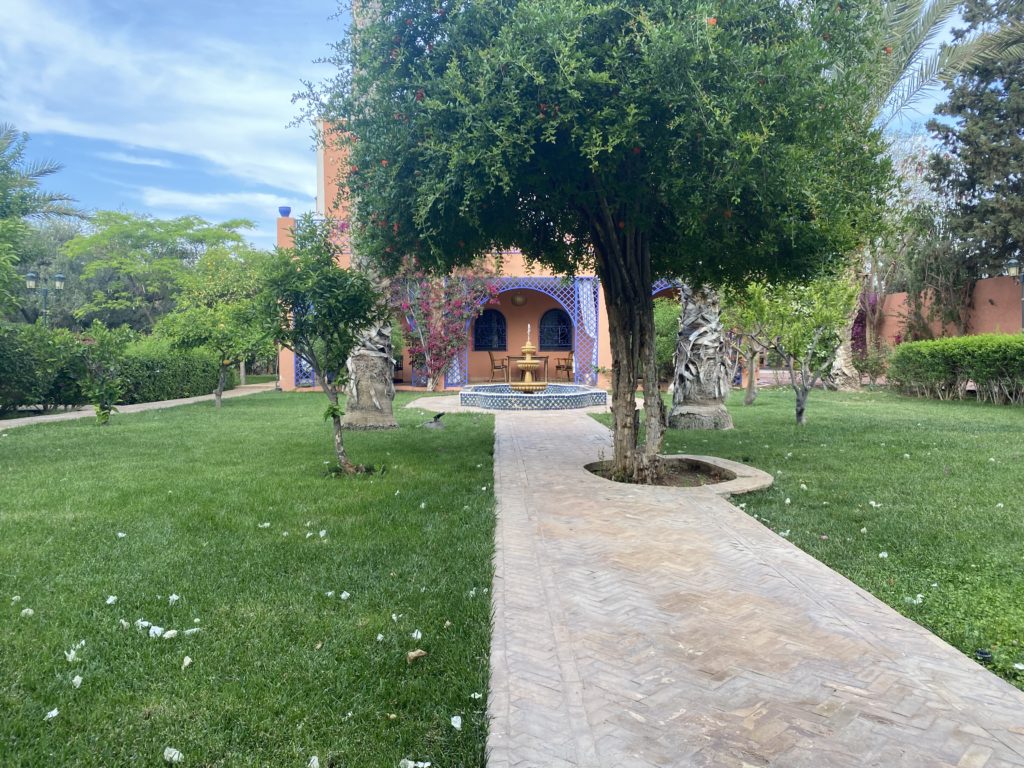
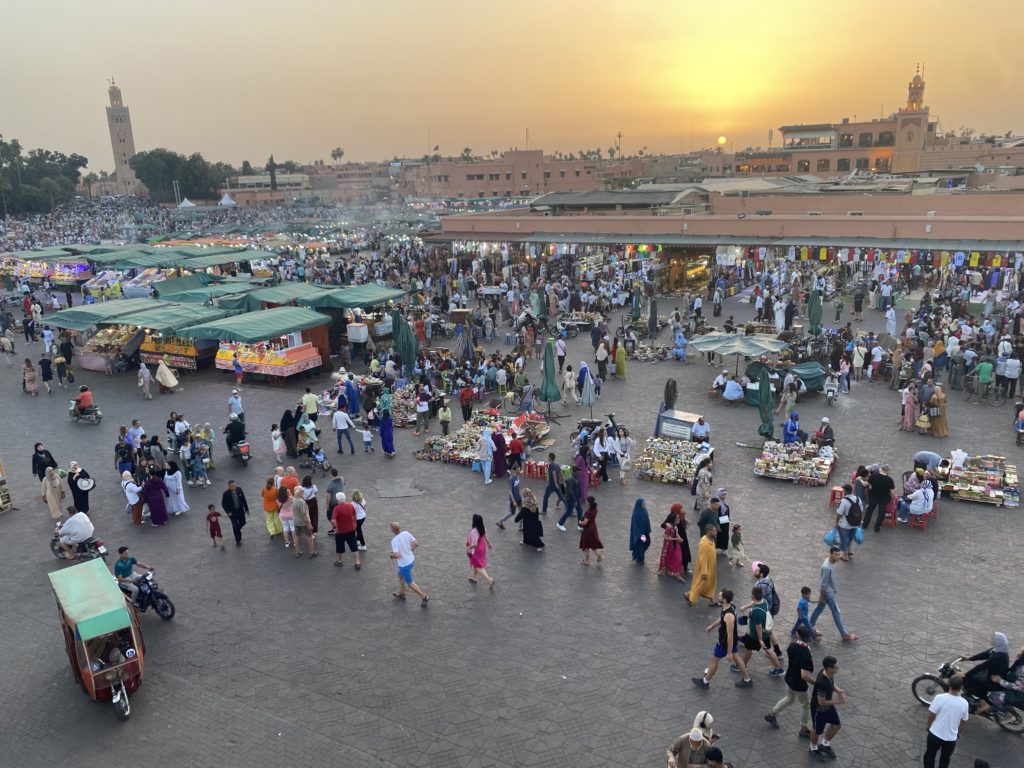
As the sun began to set, we were picked up by our driver and transported back to the Riad for dinner in the serene garden. We savored the taste of traditional Moroccan cuisine and took the opportunity to get to know each other better, sharing our excitement for the upcoming adventure.
DAY TWO
Rise and shine, our adventurous group of storytellers was ready to hit the road, but little did we know that our patience and flexibility were about to be tested. Breakfast at the hotel took longer than expected, thanks to the Eid festivities and most of the staff being on holiday. The hotel manager was doing his best, but we knew we had to take it in stride – this was just the beginning of many lessons in patience and flexibility that we would learn during our time in Morocco.
We hopped into our van and began our journey to our first storytelling project, which was a few hours’ drive away. To break up the drive, we decided to make a few stops at popular tourist attractions. First on the list was Agadir Oufla, which offered breathtaking views of the city and the sea. We couldn’t resist taking pictures and enjoying the scenery.
As lunchtime approached, we headed to the local fish market, where we indulged in some adventurous (but delicious) eating. We then took a stroll along the beach, dipping our feet into ‘the other side’ of the ocean and people-watching. With cameras in hand, we captured every moment, even taking photos for friendly Moroccans who eagerly exchanged WhatsApp contacts so we could send them the pictures later.
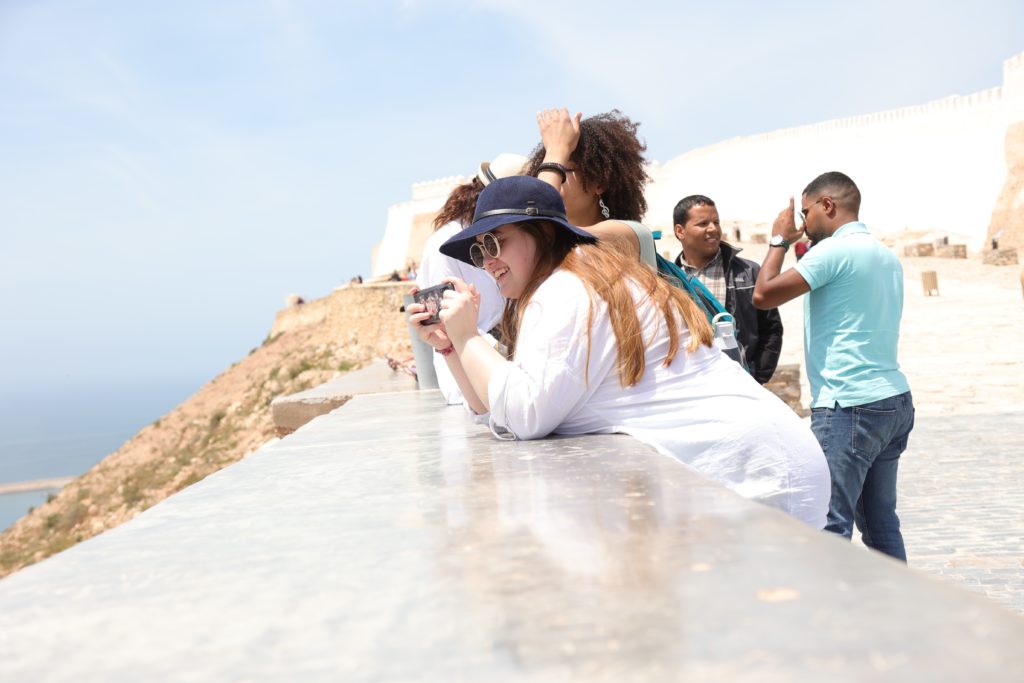
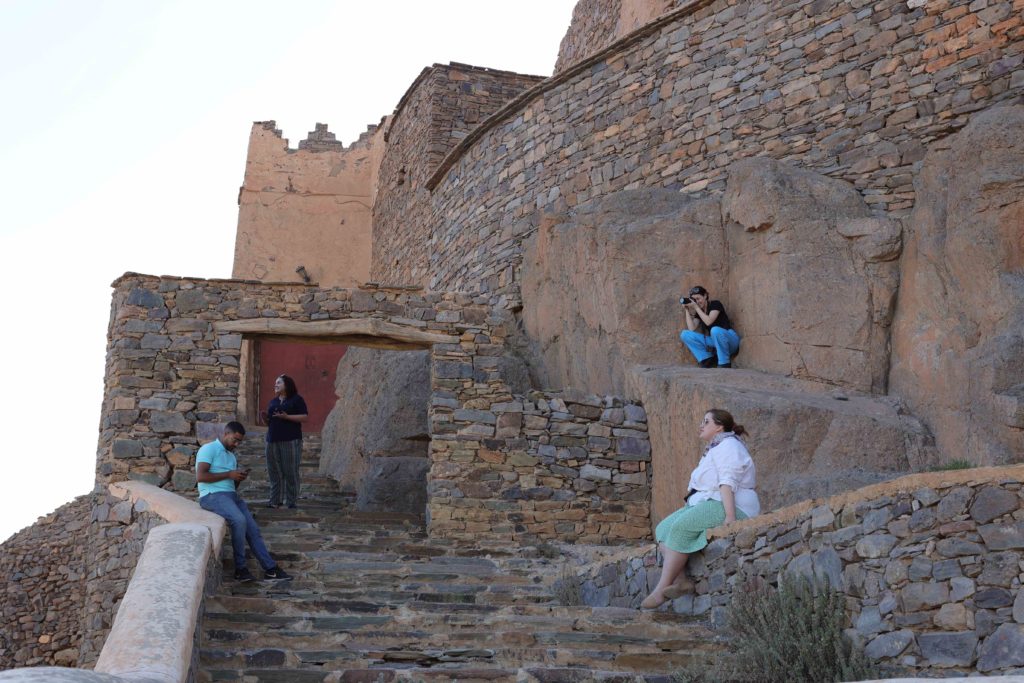
Our next destination was Kasbah Tizourgane, a small fortified village dating back to the 13th century. Unfortunately, we arrived too late to go inside, but the sight of the ancient structure as the sun set was still worth the stop.
After a long day of travel, we checked into our cozy guest house, Hotel L’Arganier d’Ammelne, just after dark. We were invited to a dinner at the hotel, which was a perfect end to our first day in Morocco. Everyone was exhausted and eager to rest up for our first day of storytelling projects.
DAY THREE
Our journey took us to the Cooperative Tifaouine Ameln, nestled near the quaint village of Tafraoute. As we arrived, we were greeted by a vivacious and warm-hearted 70-year-old woman named Khadisja El Harim, the founder and leader of the cooperative. Her passion for hosting visitors was contagious, and we couldn’t wait to learn more about their work.
Shortly after, Khadisja’s daughter, Rachida Boussine, joined us. Fluent in English, French, Arabic, and Tamazight, Rachida helped us connect with the other women in the cooperative and understand their inspiring stories.
Over morning tea, we listened intently to the women’s experiences, the challenges they face, and their pride in producing couscous and argan oil. We learned that the cooperative comprises 68 members who work collaboratively to create a variety of cultural products.
Excitement filled the air as the women prepared to show us their handmade couscous process. They had even cut their Eid celebrations short to meet us! As they worked, our crew documented the process from all angles with still and video cameras.
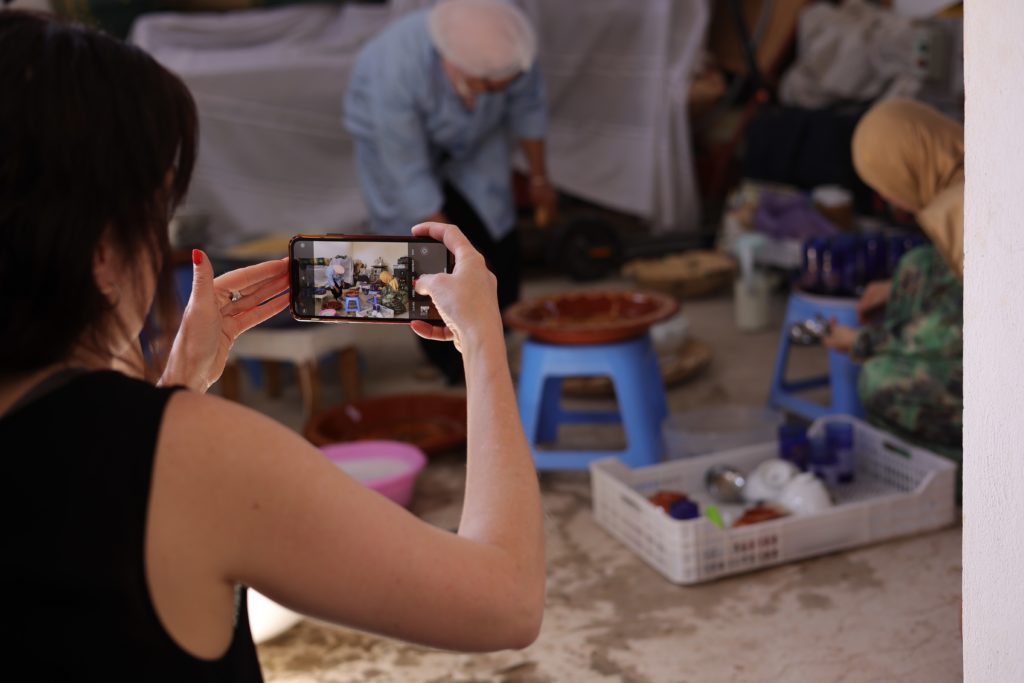
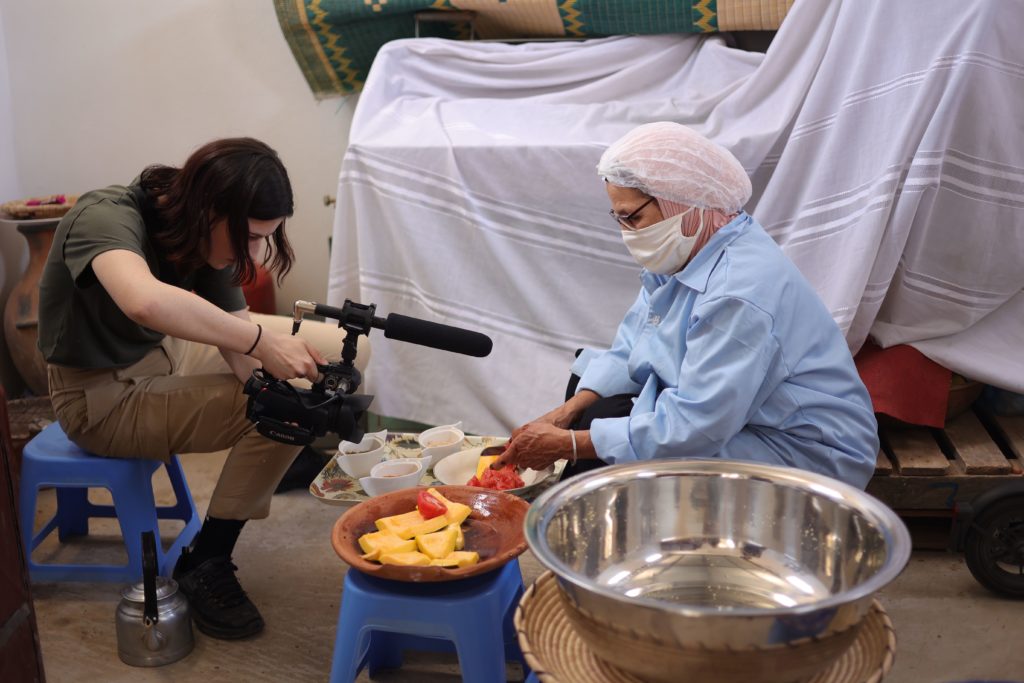
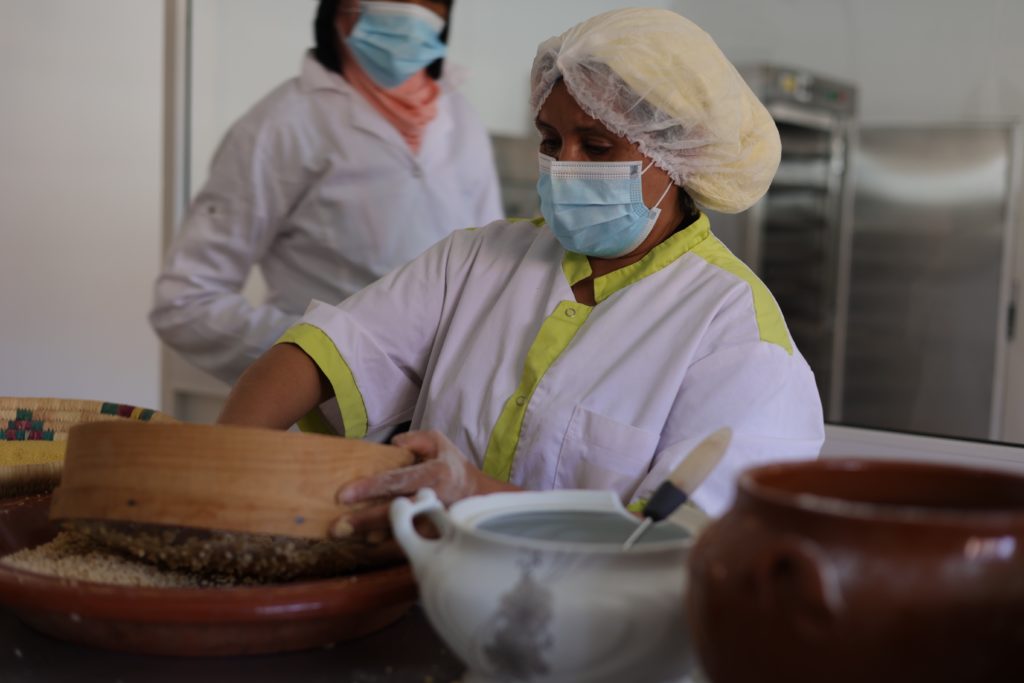
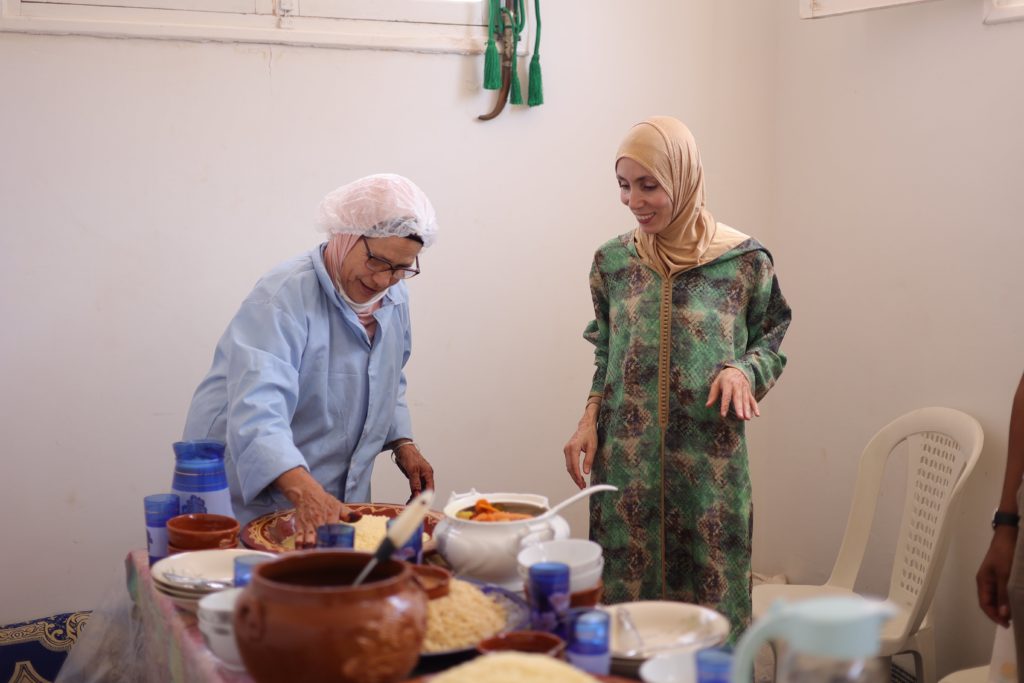
In addition to preparing couscous for sale, the women also prepared a batch of couscous to cook immediately and invited us to lunch. We savored the traditional Moroccan meal and the great hospitality. It was a meal that we will never forget, filled with delicious flavors and heartwarming company.
After lunch, we explored the breathtaking rock formations towering over the nearby village. The beauty of nature gave us time to reflect on the wonderful experience we had just had with the cooperative.
As the evening fell, we discussed our plans for the Tifaouine Ameln storytelling project(s). We knew that the stories of these incredible women needed to be shared with the world. And so we prioritized what we needed to do on our second day with them.
DAY FOUR
For the second day in Tifaouine Ameln, our first priority was to conduct formal interviews with Khadijsa and her daughter Rachida. However, finding a suitable location for the interviews proved to be challenging. While we weighed our options, the gracious women of Tifaouine Ameln prepared morning tea for us once again and set it up outside under a shady tree. We sipped tea, chatted, and enjoyed each other’s company while taking in the beautiful scenery.
After much consideration, we decided to conduct the interviews indoors, despite the clinical white walls. With Khadija as the focus, we set up a two-camera setup, and everyone on the crew served a specific role. Khadija spoke in Moroccan Arabic with our translator facilitating the questions and answers into English. Rachida’s interview followed, conducted in English with occasional translations from Moroccan Arabic.
Once the interviews were finished, we were treated to a traditional argan oil process demonstration which we documented from all angles. The women sat in a circle, working together to create their products while singing rhythmically. It was a breathtaking display of culture, connection, and womenhood.
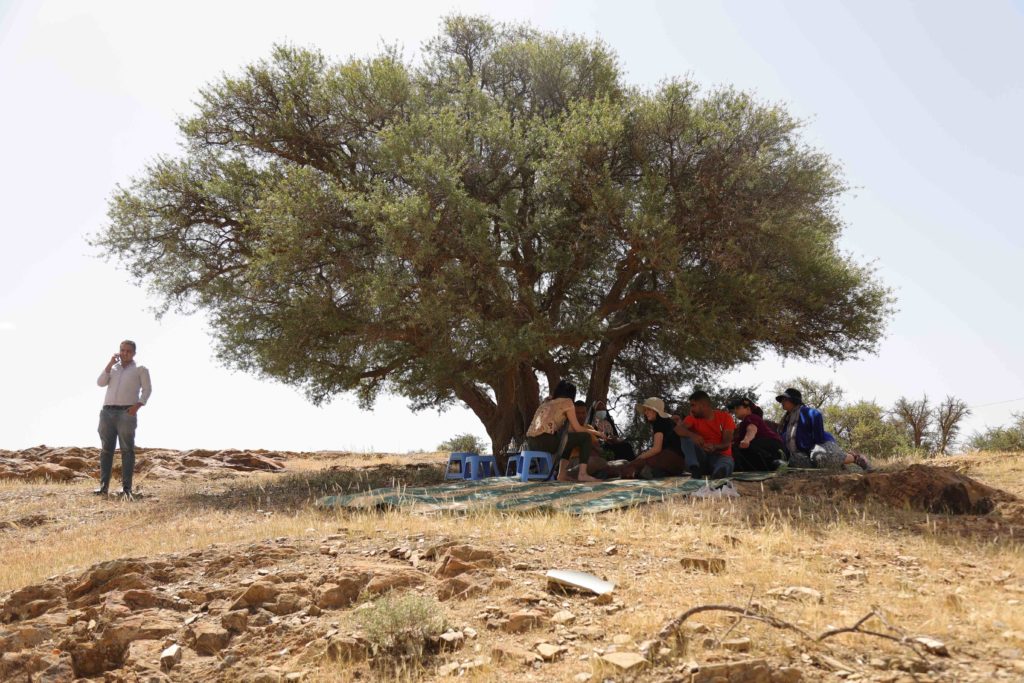
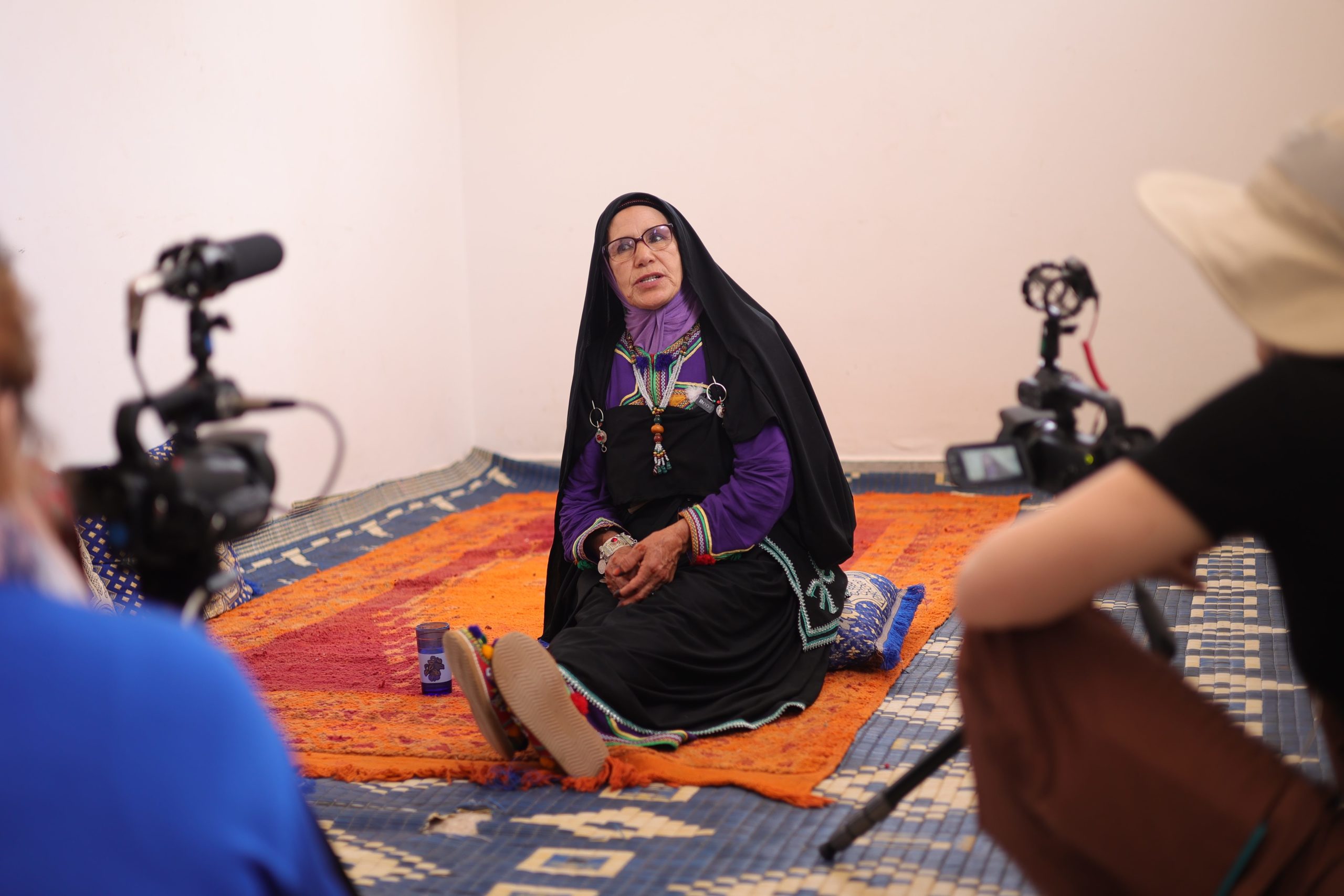
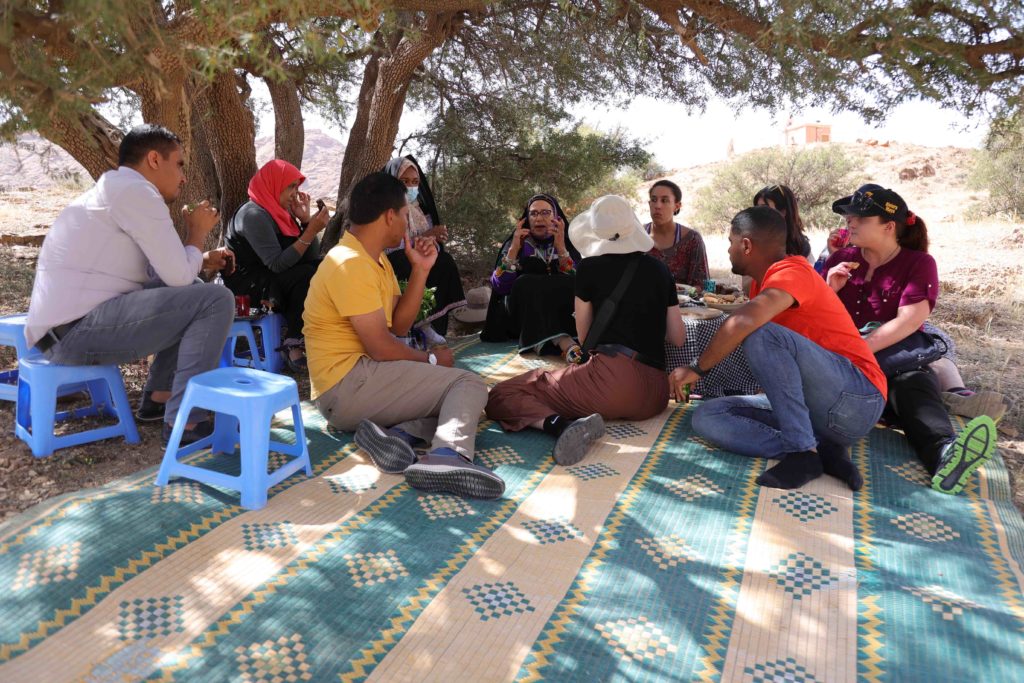
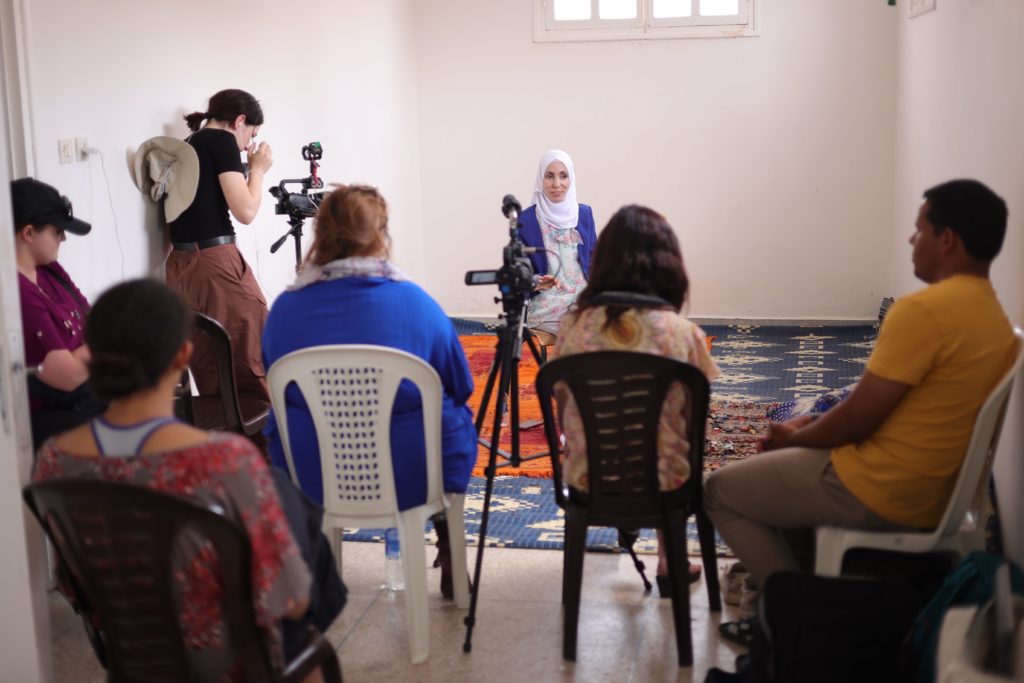
As we reached mid-afternoon, we piled into our van and set off for another community lunch, but as we approached the village, the narrow streets and tight corners made it impossible to drive any further. Undeterred, we got out and walked the remaining 10-15 minutes, taking in the sights and sounds of the village as we went. We passed by charming traditional houses, some meticulously maintained and others in a state of disrepair, providing a glimpse into the history and culture of the region.
The restaurant itself was located in the owner’s home, and we were welcomed like friends. We dined on a new-to-us local specialty, a sweet noodle dish, that was both surprising and delicious.
After lunch, some of us decided to head back to the cooperative to capture a few more exterior photographs. As the light was now softer, we knew it would be the perfect time to take some stunning images. What was meant to be a quick stop turned into a lovely social hour with Khadija and the other women of the cooperative. We shared stories of our lives, laughed, and enjoyed each other’s company.
We also wanted to make sure we had their full consent for all the photography and video footage we had documented. So we took the opportunity to discuss our post-production process and timeline, ensuring that they were comfortable with how we would be using their images. Our commitment to free, informed, and continual consent with all changemakers and culture keepers we document is essential to our work, and we wanted to make sure they knew that.
Our final night at Hotel L’Arganier d’Ammelne was a joyous celebration. The hotel hosted Moroccan musicians after dinner, and a dance party broke out between our crew and the large group of French retirees staying at the hotel. We even celebrated one of our crew members’ birthdays with songs in multiple languages and cake.
DAY FIVE
We embarked on a breathtaking drive through the winding roads of the Moroccan Anti Atlas mountains, which led us to the charming village of Taliouine. Upon arrival, we were greeted by a warm welcome from a Moroccan filmmaker, who invited us into his home for tea and delicious cookies. As we sat cross-legged on the carpets, savoring every bite of the multi-course lunch, we got to know our host and his extended family who joined us.
Our gracious host even offered to give us a tour of his village, but we had other plans. We were eager to visit a Saffron Cooperative that we had heard about, which turned out to be quite different from what we expected. As we arrived at the cooperative, we couldn’t help but feel a little distracted and restless, anticipating an experience that was similar to our previous visit. However, as we soon discovered, each cultural experience is unique, and we had much to learn.
Despite it not being saffron harvest season, we were still fascinated by the operations of the cooperative. The 70 farmers, consisting of 60 men and 10 women, have been in business for several decades and have turned their cooperative building into an aesthetically pleasing environment that welcomes many tourists.
Although we arrived at the Saffron Cooperative during the off-season, our curiosity was piqued when we heard that the cooperative had never had any professional photographs taken of their products, packaging process, or cultural rituals involving saffron. With our passion for storytelling and photography, a couple of our crew members immediately seized the opportunity to document and capture the essence of this unique cooperative.
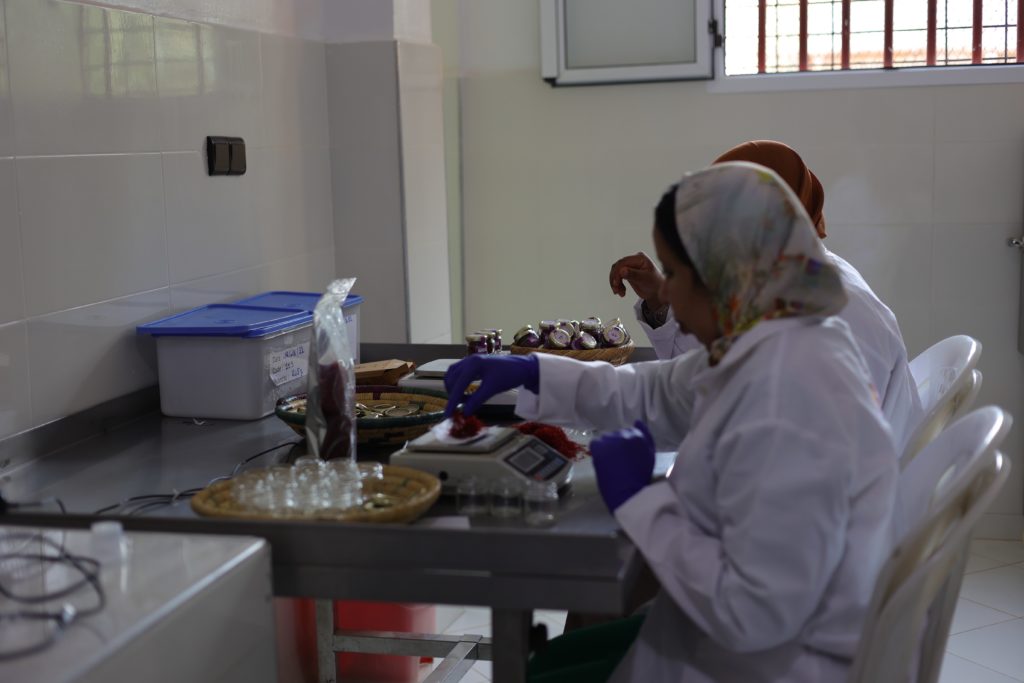
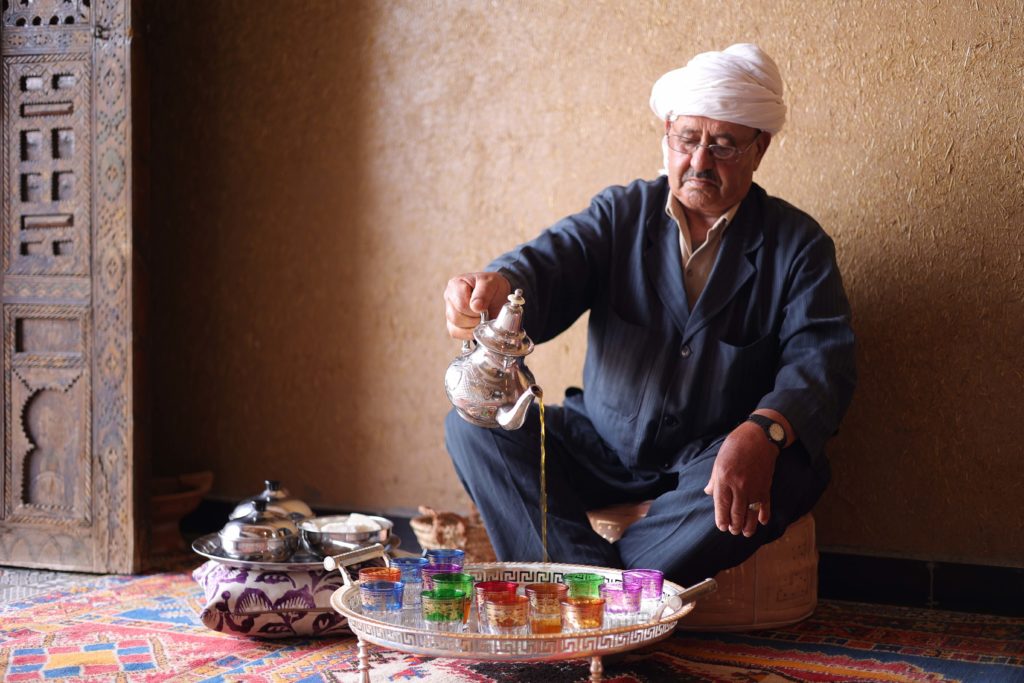
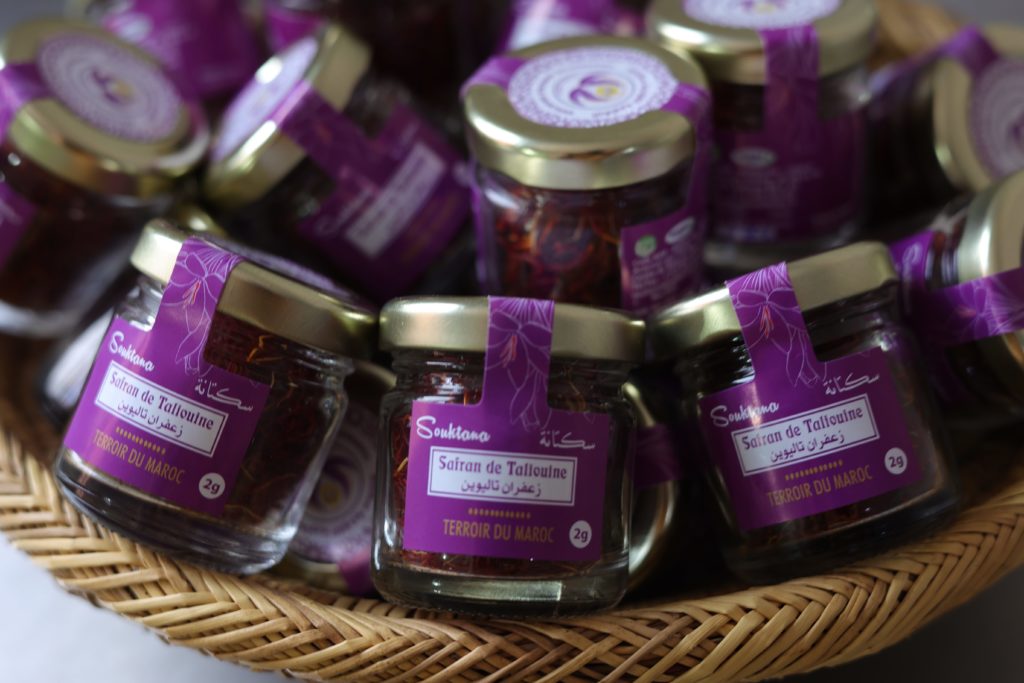
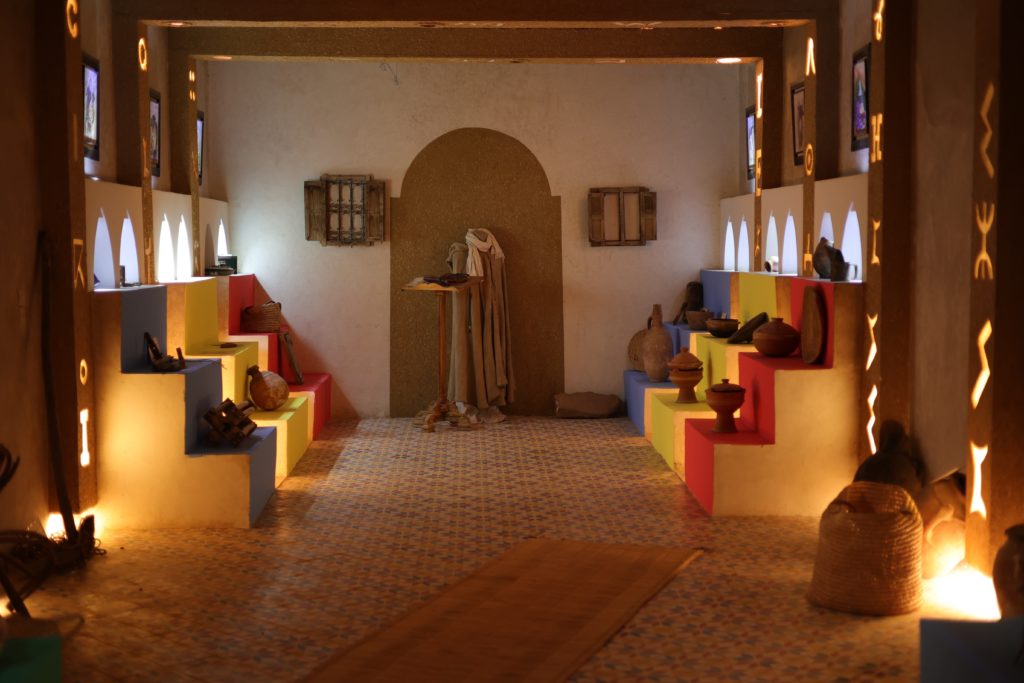
Saida Abkar, the Director of the cooperative, explained to us the impact of climate change on their business. While they used to produce up to 250 kilos of saffron each year, in recent years, they are lucky to produce even 170 kilos. It’s a harsh reality that affects the livelihood of the farmers and their families.
In the evening, we took a walk down the small main street of Taliouine, in search of a local grocery store or market to buy snacks and other supplies. The experience provided us with a unique opportunity to compare and contrast local market shelves with the products and presentation back home, offering a profound cultural insight.
DAY SIX
Our day was an exciting journey filled with breathtaking sights and cultural experiences in rural Morocco. Our first stop was an outlook where we were greeted by the stunning view of a palm oasis surrounded by a vast desert.
Next, we visited a traditional kasbah that was once the home of the governor. Although much of the kasbah has fallen into ruins, parts of it are still inhabited by the former ruler’s extended family. The restored sections were just enough for us to appreciate the architectural beauty of the past.
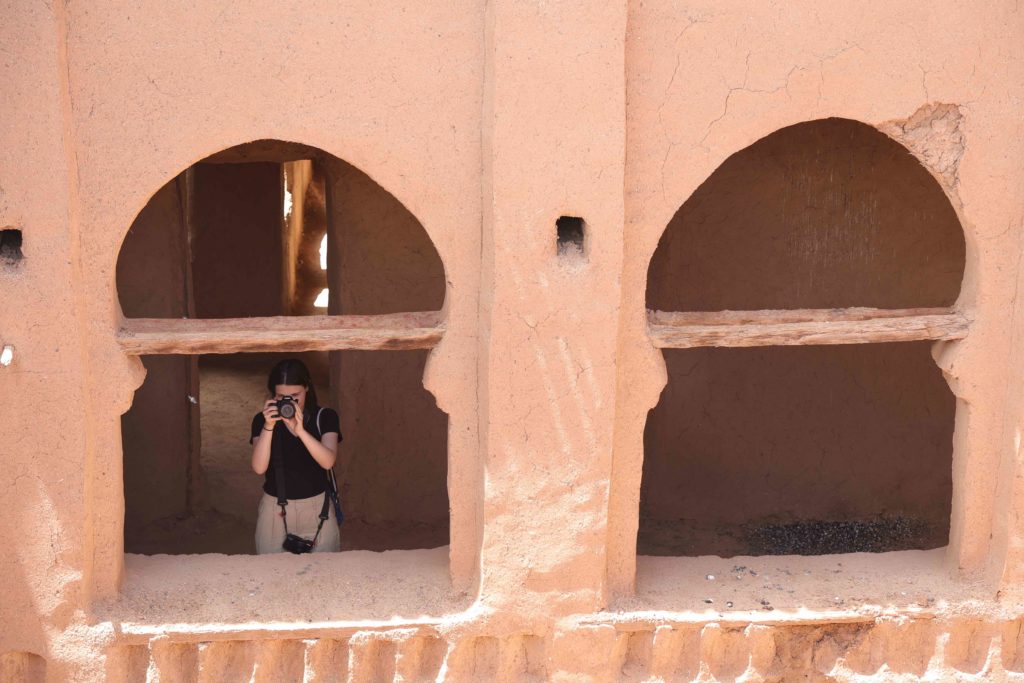
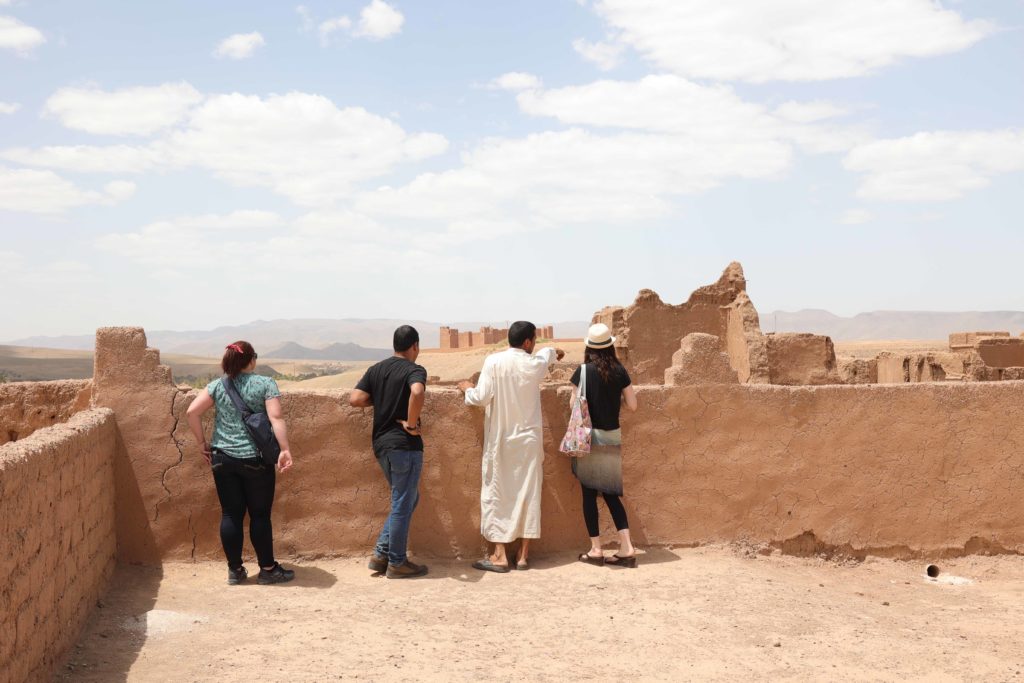
Our lunch at a charming roadside cafe was a pleasant change of pace as we finally had the option to order from a menu. We savored the opportunity to customize our meals to our liking, a break from the typical family-style dining we had experienced during our trip.
The drive along Jbal Saghrou’s hairpin mountain turns was an adventure in itself. Although the road was bumpy, the views were awe-inspiring, and we couldn’t resist stopping to take some photos.
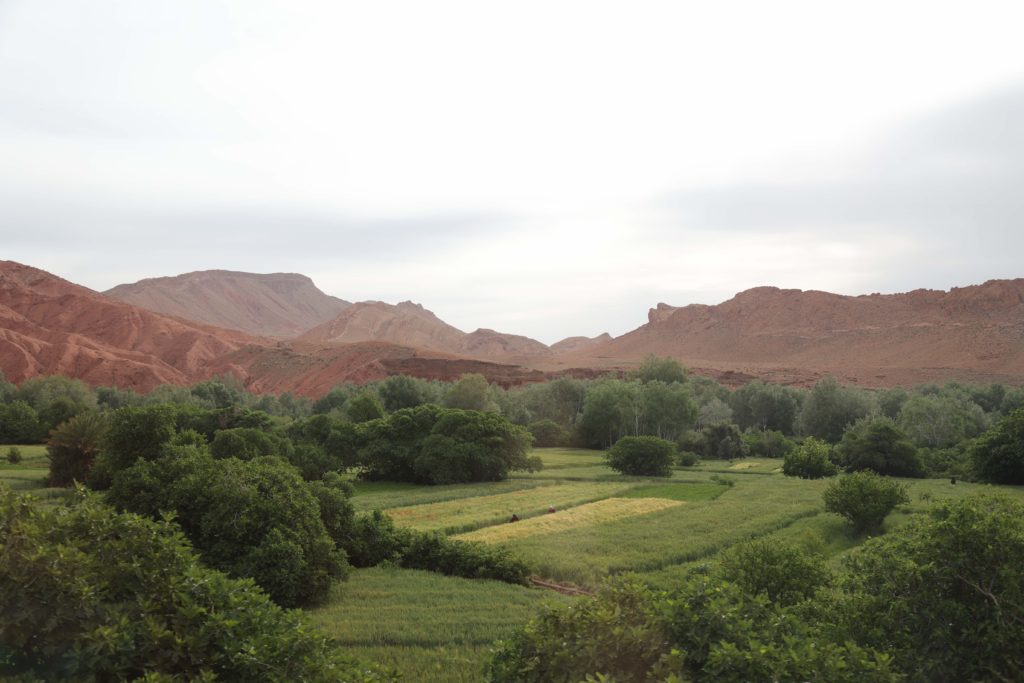
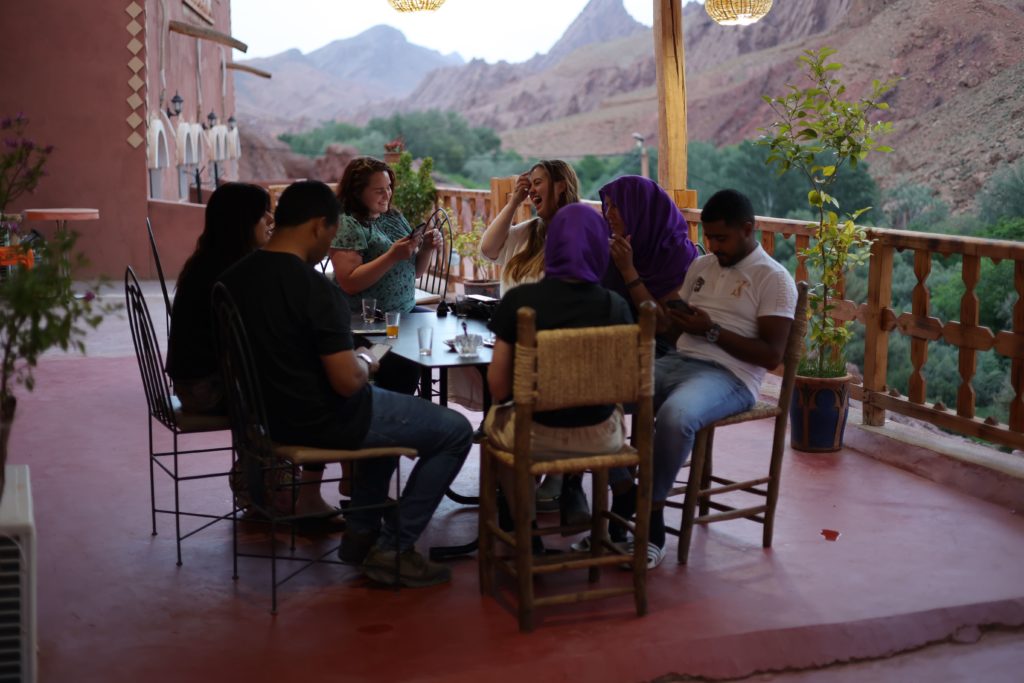
Upon arriving at the Dades Gorges, we were struck by the natural beauty of the area. The contrasting colors of the red cliffs above and the green trees and gardens below the river were a sight to behold. The cooler weather in this region was a refreshing change from the hot days we had encountered earlier in our journey.
Finally, our day ended with a stay at the Auberge Atlas Dades hotel, which boasted picturesque views that we won’t forget anytime soon.
DAY SEVEN
This day was filled with the sweet fragrance of roses and the inspiring story of the Cooperative Taytmatine. They are a group of eight women who have dedicated themselves to producing exquisite handcrafted products from the damask rose, which is native to their region. We were fortunate enough to visit during the Rose harvest and witness the entire process of making rose oil and rose water.
But before we even brought out our cameras, we sat down with two leaders of the cooperative to learn about their work and the challenges they had faced in getting started. We were moved to hear from Fatima, the treasurer of the cooperative, about the pushback they had received from male members of their community who disapproved of women engaging in any kind of work outside the home.
Despite the obstacles, the women of Taytmatine persevered, driven by their desire to contribute to the well-being of their families and their community. It was heartening to see that they had the full support of their husbands, who recognized the importance of their work.
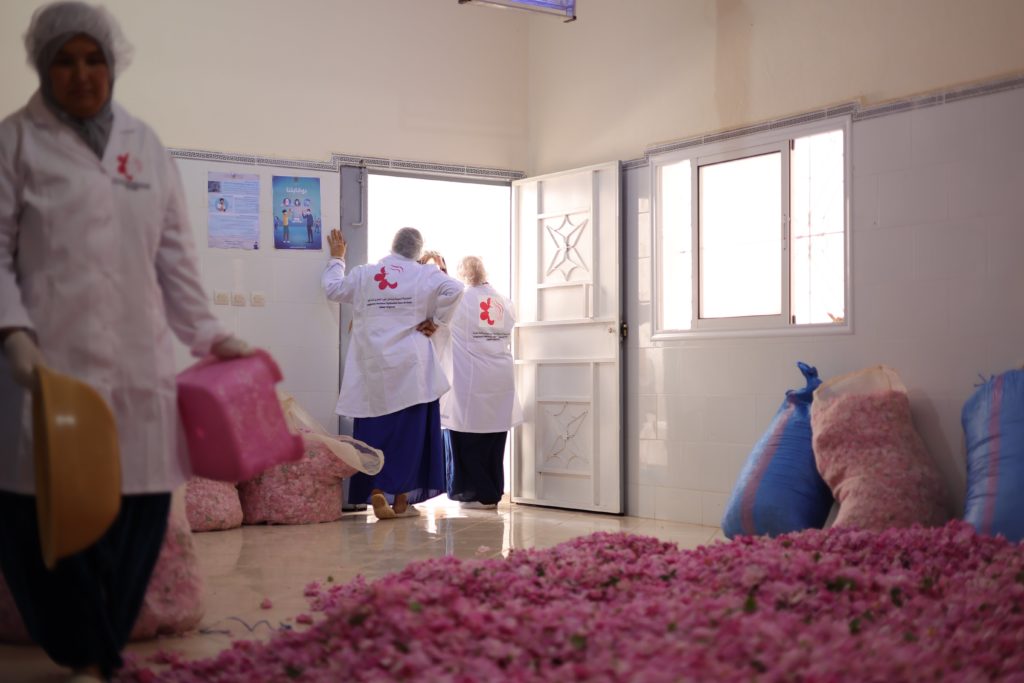
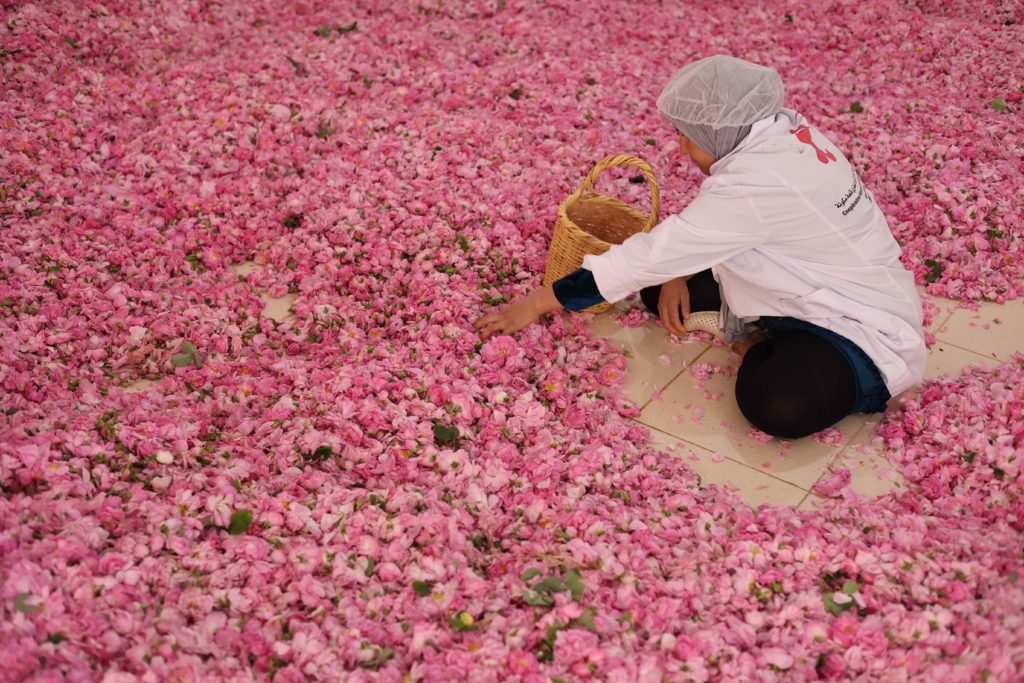
Tea time was a welcome rhythm to our day, and as we awaited the arrival of the roses, we learned about the cooperative’s process from the man they employ to collect the freshly picked flowers. We were awestruck as we watched the roses being sorted and separated on the floor of the cooperative’s largest room, surrounded by the women working tirelessly.
While some of our crew went off to explore the nearby Rose Festival, the rest of us continued to document the production process and enjoyed a wonderful lunch of couscous prepared by the cooperative. We then had the privilege of interviewing Fatima, who shared the history of the cooperative, the struggles they had overcome, and their unwavering commitment to their craft.
The women of Taytmatine are an inspiration, and their story serves as a reminder of the challenges that many women in Morocco face. We are grateful to have had the opportunity to learn from them and to share their story with the world.
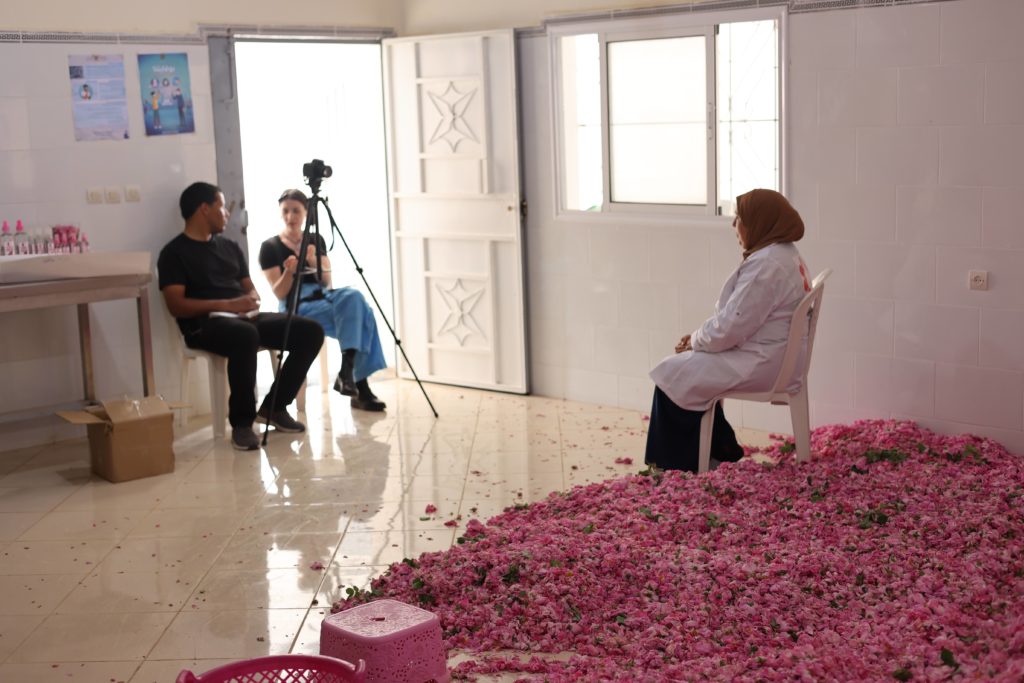
Alongside our storytelling project, it also become evident that tensions amongst our crew were beginning to rise. As with any group travel, navigating different personalities and priorities can be challenging, and citizen storytelling in a foreign land presents its own unique set of obstacles. It wasn’t long before unmet expectations and conflicting priorities came to a head, causing internal conflict among some in our group.
As the day came to a close and we gathered for dinner, several members of our crew took a deep breath and bravely opened up about the difficulties they were facing. Through a heartfelt and honest discussion, we were able to address the insecurities and struggles that came with our storytelling experience. While conflict resolution is not a typical activity on a holiday, it was a necessary process for us to move forward and work together more effectively. By holding space for respectful communication, we were able to progress towards a greater understanding of each other, and a renewed commitment to our shared goals.
DAY EIGHT
Our final storytelling project of the expedition was with Le Ksar Du Tapis, a rug cooperative. We were eager to explore this cooperative that was established to empower Amazigh families and enable the women weavers to earn a fair wage for their artistry. As we were told, the women weave the carpets and then men sell them. So it was the men who warmly greeted us in English upon entry to the cooperative, offering us the obligatory mint tea. The cooperative, located at the “gateway to the desert,” was filled with vibrant rugs that adorned the walls and benches, but it was the group of Amazigh women weavers working on a traditional loom who captured our attention.
Despite the banter between them, the weavers took the time to share their stories with us. Born and raised in the same village, Rabha Jalali, Khadoja Louardi, and Habiba Aghzaf have known each other since childhood. Weaving rugs is a cultural practice that goes back centuries, and through their artistry, these women celebrate their shared heritage and infuse every carpet with a story. As they work on each carpet, they pass down techniques and secrets from one generation to the next, preserving the wisdom and traditions of their ancestors.
For Rabha, Khadoja, and Habiba, weaving is not only a form of cultural preservation but also a means of livelihood. They take on the financial responsibility of providing for their families with their work at the loom. Despite the language barrier, our conversation was facilitated through two men at the cooperative, who shared with us the stories of these women and their dedication to their craft.
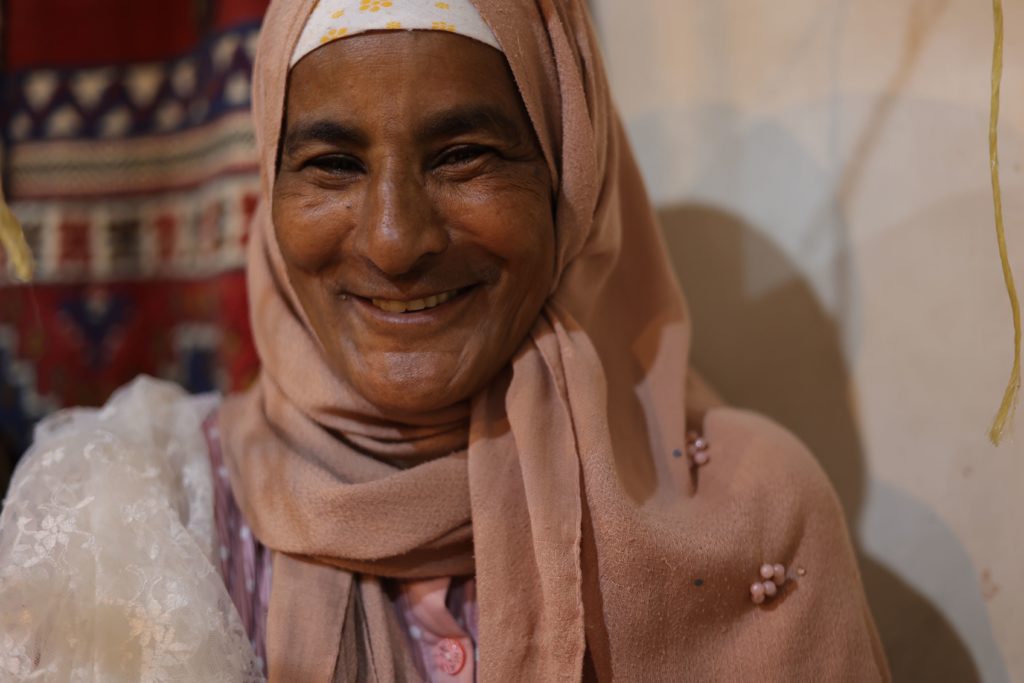
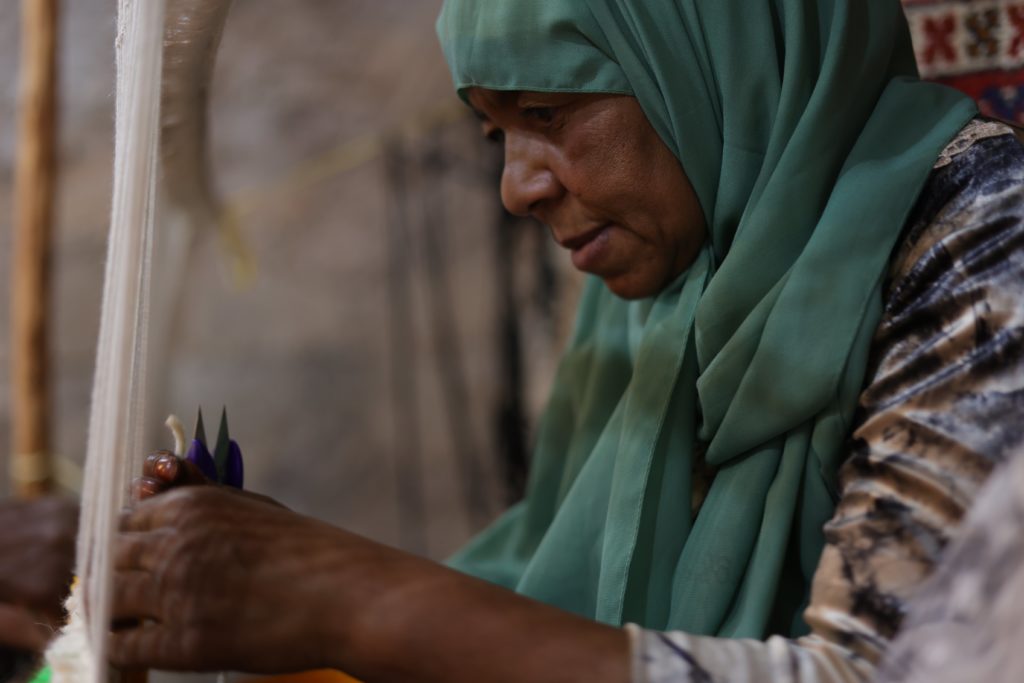
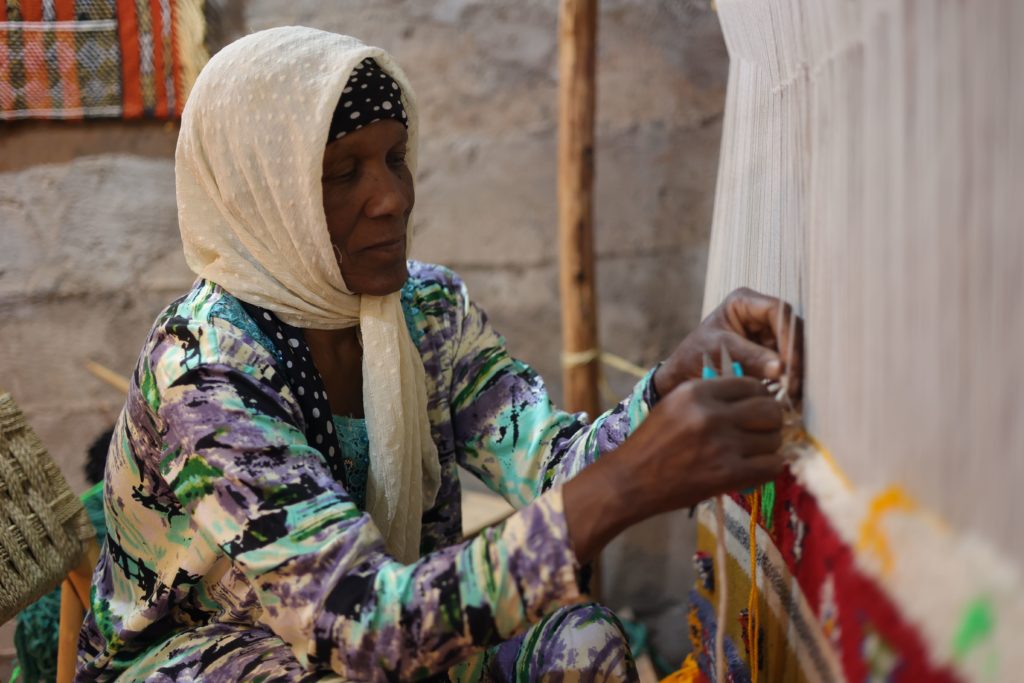
As we walked around the cooperative, admiring the artistry of the rugs and taking photographs in the ornate doorways, we couldn’t help but feel inspired by the women’s determination and passion for their work. We learned that within this cooperative (not all rug shops or even cooperatives are created equal) the weavers retain 90% of the sale price of each rug they create and they are sold largely to visitors who come to the shop. Our visit to the cooperative was a powerful reminder of the impact that responsible tourism can have on the lives of individuals and communities.
DAY NINE
Our adventure in Morocco was coming to a close, and while we were sad to say goodbye to this enchanting country, we had a few more stops to make before returning to Marrakesh.
As we drove through the town of Ourzazate, we couldn’t help but notice the stark contrast between the bustling Hollywood-style movie studios and the traditional cultural experiences we had been enjoying throughout the majority of our trip. However, we were determined to make the most of our remaining time in Morocco.
Our first stop was at a spice cooperative, and while we didn’t plan on documenting our visit, we were treated to an entertaining presentation by Ishmael at The Caravan Of Spices. The fragrant smells of exotic spices filled the air as we learned about the different uses and benefits of each one. We were all charmed into purchasing spices, remedies, and trinkets to take home with us.
Next, we visited the Atlas Movie Studios, which had been eagerly anticipated by some of the filmmakers in our crew. Unfortunately, we found the studios rather unremarkable, and the experience left us feeling a little underwhelmed. Perhaps it was because we had already been so deeply immersed in the culture and beauty of Morocco, but we felt that the studios paled in comparison.
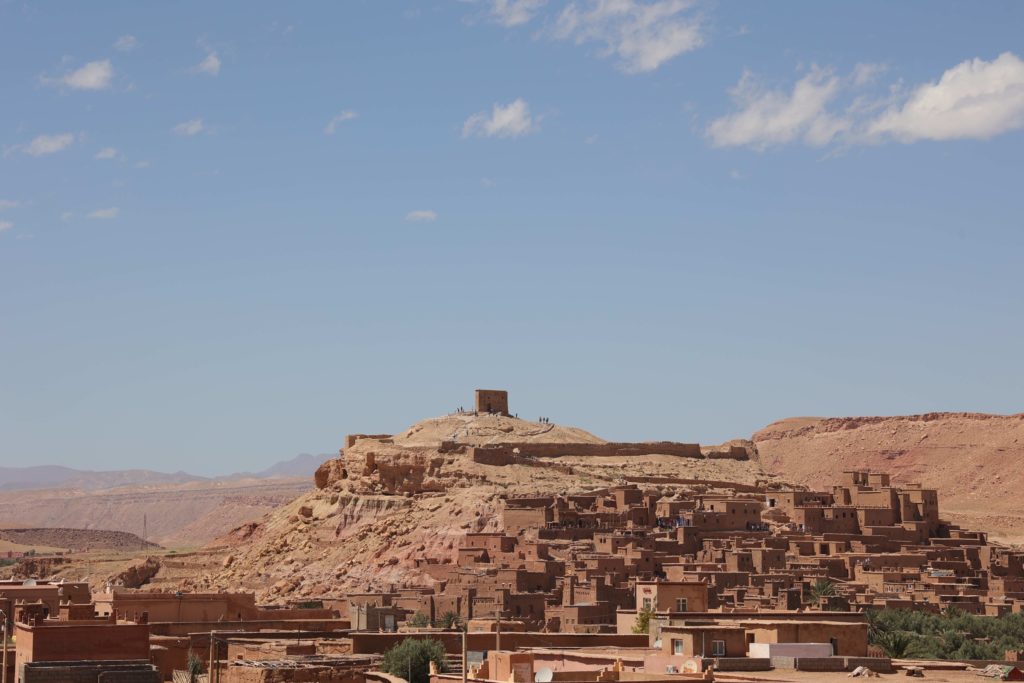
As we sat down to enjoy lunch outside with a view of the famous Kasbah, the wind kicked up, causing a sandstorm that made it difficult to concentrate on our food. We couldn’t help but feel sorry for the visitors who had climbed several hours to the top of the Kasbah, only to be hit with the wind and sand.
As the afternoon rapidly passing, we agreed to pass on the Kasbah tour and make our way back to Marrakesh before sunset. We returned to our peaceful Riad, dropped off our luggage, and headed back into the bustling Medina for some final shopping, eating, drinking, and soaking up the vibrant energy of Morocco. Even though our journey was coming to an end, the memories we made would stay with us forever.
DAY TEN
As the tour drew to a close, we said our goodbyes and parted ways. Some of us boarded flights home, while others ventured out to explore more of Morocco on their own. A few of us lingered, taking a few extra days to reflect on the incredible experiences we had just shared and to piece together the stories we had documented along the way.
Back at our temporary home in Marrakesh, we sifted through hours of footage, notes, and photographs, reliving the moments that had moved us the most. We were excited to share these stories with the world, but first, we wanted to honor the people who had welcomed us so warmly into their homes and communities.
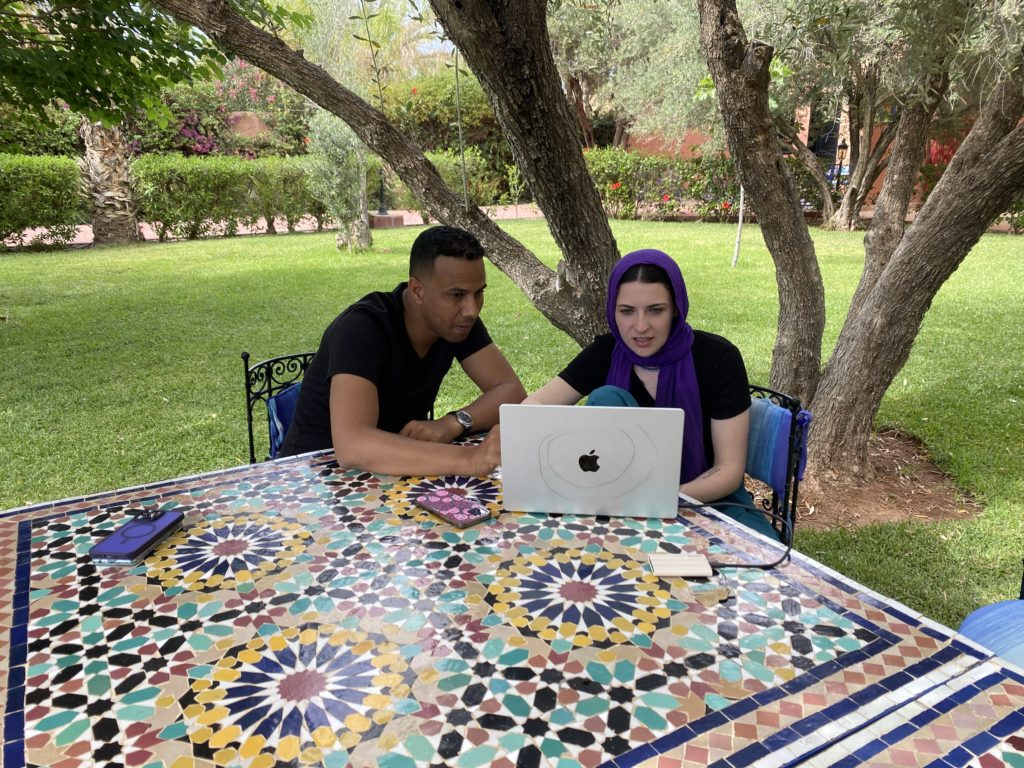
To ensure that our stories were accurate and respectful, we sought the approval of our Moroccan collaborators. They graciously reviewed our work and offered valuable feedback, helping us to ensure that our stories captured the essence of Morocco and its people.
Once our stories have been approved, we look forward to sharing them with the world. From the rugged beauty of the Atlas Mountains to the vibrant markets of Marrakesh, we hope that these tales will inspire others to explore the wonders of this incredible country. Stay tuned for our upcoming posts, where we’ll share the magic of Morocco with all who are curious.
